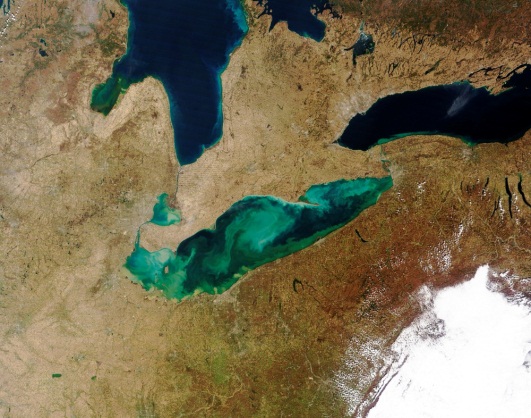The Great Lakes are an important part of Ontario’s biodiversity, economy and culture. In the past decade, increasing incidents of harmful algal blooms have threatened the integrity of the Great Lakes (OMOECC 2014; O’Neil et al. 2012 and; Paerl et al. 2011). Algal blooms occur when algal cells in lakes or rivers reach a critical concentration which makes them visible to the naked eye. Many types of algae form blooms. In the Great Lakes, the main types of algae are green algae, Cladophora or Spirogyra and blue-green algae, Microcystis (NOAA Great Lakes Environmental Research Laboratory 2014). Some blooming organisms, such as Microcystis, can contain toxins or other noxious chemicals or pathogens that can be harmful both to aquatic species such as fish and birds and to humans (NOAA Great Lakes Environmental Research Laboratory 2014; Hallegraeff 2014).
In the Great Lakes, particularly in Lake Erie, Microcystis (also known as Cyanobacteria) blooms commonly occur in late summer and early fall. When these algae bloom, they form dense mats of floating or attached green or blue-green coloured algae (FPTGC 2010). Excess algal growth threatens biodiversity by negatively impacting fish and wildlife habitat. Masses of decaying algae from blooms that lie at the bottom of lakes can deplete the supply of oxygen, creating dead zones where fish are unable to survive (Manning et al. 2013). Algal toxins can contaminate drinking water, causing serious human health issues, such as gastrointestinal discomfort and in severe cases, liver damage. They can also interfere with recreational activities such as swimming, boating and fishing (OMOE 2013). Thus, algal blooms can have serious environmental, economic and social consequences (FPTGC 2010).
A combination of factors including the presence of excess nutrients such as phosphorus and nitrogen, warm temperatures and lots of light can spur the onset of an algal bloom. In the past, excess nutrients from agriculture and urban development were the main cause of algal blooms in Lake Erie – the most vulnerable of the Great Lakes because it is shallow and warm, and therefore most productive. By the 1960s, public alarm was raised and people feared that Lake Erie was “dying” because of the appearance of filamentous algae covering beaches in green slime. Research showed that phosphorus was the main culprit, and in response, 1972 Great Lakes Water Quality Agreement introduced regulations that reduced point sources of phosphorus entering the Great Lakes (e.g., sewage treatment plants). Ten years later non-point sources of phosphorus were also controlled, leading to a clean-up of the lakes and one of the great success stories in international environmental cooperation (NOAA Great Lakes Environmental Research Laboratory 2014).
Figure 1. MODIS satellite image of Cyanobacteria bloom in Lake Erie. March 23, 2012 (credit: NASA).
In the past decade, massive toxic blue-green algae, or harmful algal blooms, have reappeared in lakes Erie, Ontario and Huron (Paerl and Paul 2012). The causes of these recent algal blooms are more complex than in previous decades and the effects are more detrimental. Increased inputs of phosphorous from agriculture as well as neighboring urban areas are thought to be one factor (Richards et al. 2008). Pesticides and other chemicals may also increase the risk of an algal bloom by reducing populations of natural grazers which would otherwise control algal growth. The presence of invasive Quagga Mussels and Zebra Mussels compound the problem due to their capacity to selectively remove edible algae, leaving behind the toxic blue-green algae, Microcystis. Blooms of Microcystis are of particular concern for two reasons: they are a poor food source for zooplankton that are, in turn, important food for fish larvae; and they can contain a toxin that, when ingested by animals, including humans, may cause liver damage (FPTGC 2014).
Climate change may also increase the frequency of algal blooms in the Great Lakes (Hallegraeff 2014). Increases in water temperatures favour the growth of some algae such as the toxic blue-green algae and the growth of these algae, in turn, further increase water temperatures by absorbing sunlight (O’Neil et al. 2012). Increased temperatures also prevent water in lakes from mixing, allowing algal mats to grow thicker and faster. Changes in salinity and higher carbon dioxide levels in freshwater lakes can also promote the growth of certain toxic algae such as the blue-green algae which have higher tolerance of these conditions. Altered rainfall patterns that increase the frequency of flooding events can also lead to higher levels of nutrient loading into the lakes (Paerl and Paul 2012).
The Great Lakes Water Quality Agreement continues to be the main driving force towards reducing the amount of nutrients loaded into the lakes by setting targets. Ontario’s proposed Great Lakes Protection Act also includes provisions for the Minister of the Environment to set targets for a range of environmental issues, such as the reduction of nutrient loading. Nutrient loading from agriculture has been regulated through the Nutrient Management Act since 2002 to prevent excess nutrients runoff into the Great Lakes.
References:
Federal, Provincial and Territorial Governments of Canada (FPTGC). 2010. Canadian biodiversity: ecosystem status and trends 2010. Canadian Councils of Resource Ministers. Ottawa, ON. [Available at: http://www.biodivcanada.ca/default.asp?lang=En&n=BAE73048-0&offset=2&toc=show]
Hallegraeff, G.M. 2014. Harmful algae and their toxins: progress, paradoxes, and paradigm phifts. pp. 3-20. In G.P. Rossini (Ed.) Toxins and biologically active compounds from microalgae. CRC Press. Boca Raton, Florida.
Manning, N.F., C.M. Mayer, J.M. Bossenbroek, and J.T. Tyson. 2013. Effects of water clarity on the length and abundance of age-0 yellow perch in the Western Basin of Lake Erie. Journal of Great Lakes Research 39:295-302.
National Oceanic and Atmospheric Administration (NOAA) Great Lakes Environmental Research Laboratory. 2014. Great Lakes water quality. [Available at: http://www.glerl.noaa.gov/res/waterQuality/]
Ontario Ministry of the Environment (OMOE). 2013. Water quality in Ontario 2012 report. Queen’s Printer for Ontario, Toronto, ON. [Available at: https://www.ontario.ca/environment-and-energy/water-quality-ontario-report-2012]
Ontario Ministry of the Environment and Climate Change. 2014. Blue-Green algae. [Available at: https://www.ontario.ca/environment-and-energy/blue-green-algae#section-0]
Paerl, H.W., N.S. Hall, and E.S. Calandrino. 2011. Controlling harmful cyanobacterial blooms in a world experiencing anthropogenic and climate-induced change. Science of the Total Environment 409:1739-1745.

